Dr. Phil Zeltzman’s Blog
How to Find a Veterinary Surgeon for your Pet (part 2)
As promised last time (How to Find a Veterinary Surgeon Part 1), we share 5 more ways to find a surgeon for your cat or your dog.

6. Visit the clinic’s web site
The web site of the clinic where your prospective surgeon works will also give you some valuable information. You can get a feel for the clinic in general and the surgery service in particular.
7. Visit the surgeon’s page
Within the clinic website, there should be a page or a section dedicated to your surgeon. You can look at their biography and learn more. You can verify the surgeon’s credentials (do they have the letter DACVS after their name?). You can tell where your surgeon studied, where he or she specialized and how long they have been in practice. You can read about professional and personal accomplishments.
8. Does the surgeon understand your needs?
When you talk to the surgeon, feel free to explain your particular situation. Do you have any special requirements? Does your surgeon understand your goals with your pet? Do you and your surgeon have the same expectations? Expectations may or may not be realistic, but can always be discussed.
9. Does the surgeon answer the tough questions?
Ask about your surgeon’s success, failure and complication rates. Nobody likes to talk about failure or complications, but it should be discussed honestly. Do you truly understand exactly what your pet will go through? Do you understand what you will need to do after surgery? How generous is your surgeon with pain medications? Who will monitor your pet during and after anesthesia?
10. Trust your intuition
During the consultation, ask questions, and decide if you feel comfortable with the surgeon. Did the surgeon explain things well? Did the surgeon use simple words? Has the surgeon performed the surgery your pet needs multiple times before?
Keep in mind that some conditions are rare, and therefore that particular surgery may be performed rarely.
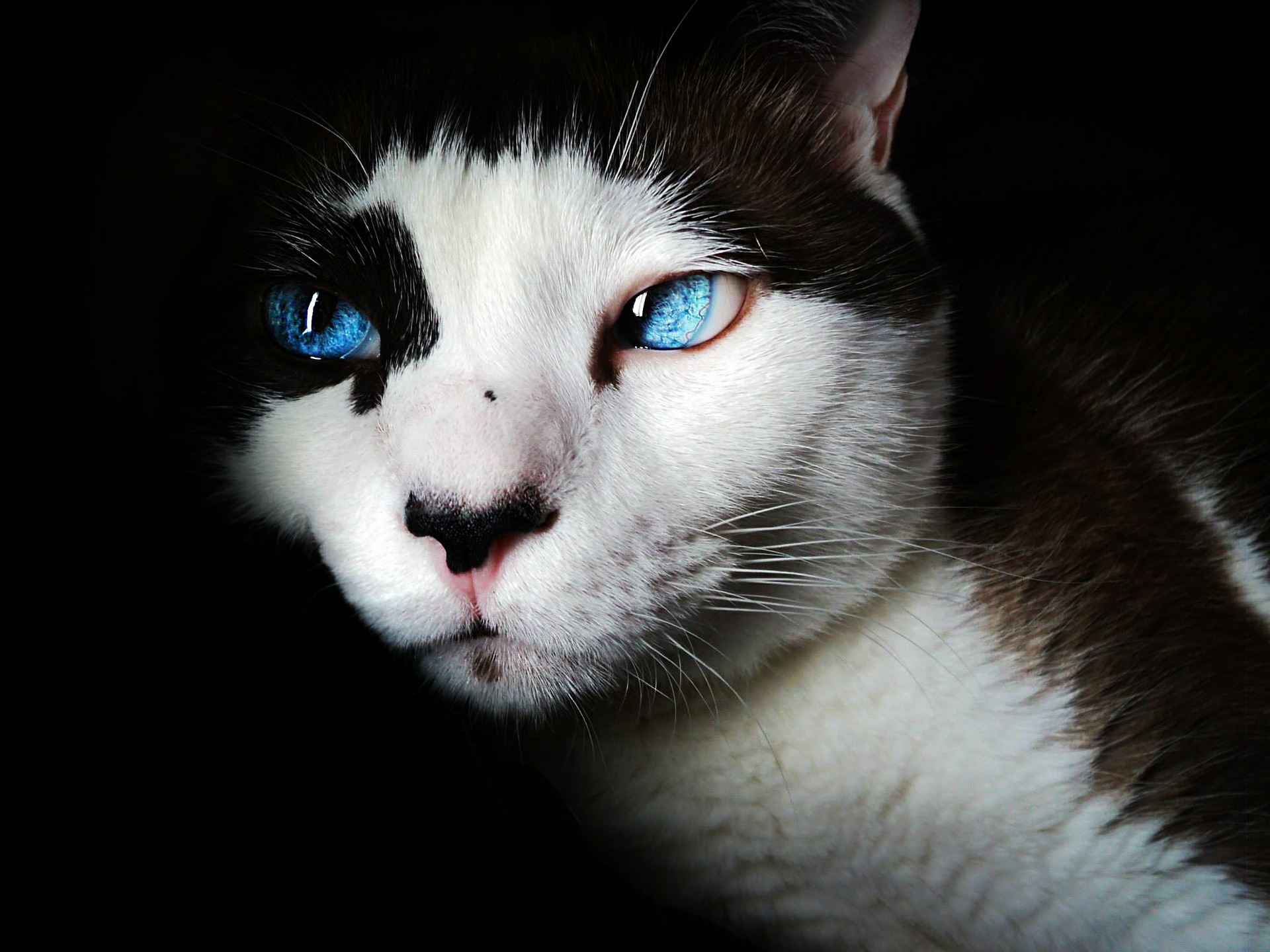
11. Bonus: a traveling surgeon
There is one more solution you may find convenient. Your family vet may work with a traveling surgeon. In this case, the surgeon comes to your vet’s hospital to perform specialty surgery. You don’t need to travel anywhere. This instantly fulfills several of the criteria above. Clearly, your vet would trust the surgeon they work with!
Called me biased since I am a traveling surgeon, but there are many benefits to staying local.
Ultimately, your choice of surgeon has a lot to do with trust. You need to find a surgeon you trust to operate on your beloved pet. Once that happens, you can in turn help other pet owners and their pets by referring them to someone you trust.
Phil Zeltzman, DVM, DACVS, CVJ, Fear Free Certified

Dr. Phil Zeltzman is a traveling veterinary surgeon in Pennsylvania & New Jersey. An award-winning author, he loves to share his adventures in practice along with information about vet medicine and surgery that can really help your pets. Dr. Zeltzman specializes in orthopedic, neurologic, cancer, and soft tissue surgeries for dogs, cats, and small exotics. By working with local family vets, he offers the best surgical care, safest anesthesia, and utmost pain management to all his patients. Sign up to get an email when he updates his blog, and follow him on Facebook, too!
How to Find a Veterinary Surgeon for your Pet (part 1)
If you are starving for Thai food or tapas, how do you choose a restaurant?
If you are looking for a car with great gas mileage, where do you turn?
If your cat or your dog needs surgery, who should you trust?

You can probably think of a few ways to answer the first two questions. The third question is probably more difficult to answer. Fortunately, this blog can help.
When your pet needs surgery, you have a choice: you can use your family vet, or you can enroll the help of a surgery specialist. If your vet recommends a surgery specialist, how should you decide? You probably shouldn’t pick a surgeon the way you choose a restaurant or a car dealer. After all, we are talking about your beloved pet.
What is a surgeon?
In the US, a surgeon is someone who only performs surgery. Technically, and I realize this is slightly controversial and extremely confusing, the only person who can claim to be a surgeon is somebody who is board-certified in surgery. In the US, a veterinary surgeon has undergone additional training after college (4 years) and vet school (4 years) in order to become a specialist. This training consists of a minimum of a 1-year internship followed by a 3-year residency.
So that’s at least 12 years of training! Then they need to pass the difficult exam of the American College of Veterinary Surgeons (ACVS).

Here are some suggestions to help you find the right person to perform surgery on your pet.
1. Ask your vet
Can your veterinarian perform the surgery? Or should a surgeon do it? Assuming a surgeon should do it, which surgeons has your vet had a good experience with? What kind of results has your vet heard about? What was their complication rate? Were previous clients happy with their decision? Feel free to ask questions.
2. Ask other pet owners
Your vet should be able to put you in touch with other pet owners who have experience with the prospective surgeon– with their permission of course. They would be an ideal source of information since they have already lived what you will go through.
3. Ask friends and family
Similarly, if you know of friends and family members who have used a surgeon for their pet, ask for feedback.
4. Beware of social media
Don’t trust Yelp and other social media ratings blindly. The Internet can be a great resource for useful information, but it can also be a cesspool of complaints. Remember, far more people will post about negative experiences than positive ones. Also beware of people who have more opinions than experience.
5. Visit www.acvs.org
The American College of Veterinary Surgeons (ACVS) offers an online directory that lists all board-certified surgeons. And by the way, this is a great way to make sure that your surgeon truly has the credentials claimed. You can search by location (worldwide) or by name. There is some basic information about each surgeon, and usually a link to the clinic’s web site.
We will go over 5 more ways to find a surgeon next time – plus a bonus 11th way!
Phil Zeltzman, DVM, DACVS, CVJ, Fear Free Certified

Dr. Phil Zeltzman is a traveling veterinary surgeon in Pennsylvania & New Jersey. An award-winning author, he loves to share his adventures in practice along with information about vet medicine and surgery that can really help your pets. Dr. Zeltzman specializes in orthopedic, neurologic, cancer, and soft tissue surgeries for dogs, cats, and small exotics. By working with local family vets, he offers the best surgical care, safest anesthesia, and utmost pain management to all his patients. Sign up to get an email when he updates his blog, and follow him on Facebook, too!
Major needs brain surgery!
Major, a cute 3 month old German shepherd, suffered severe injuries after he was attacked by a much bigger dog.
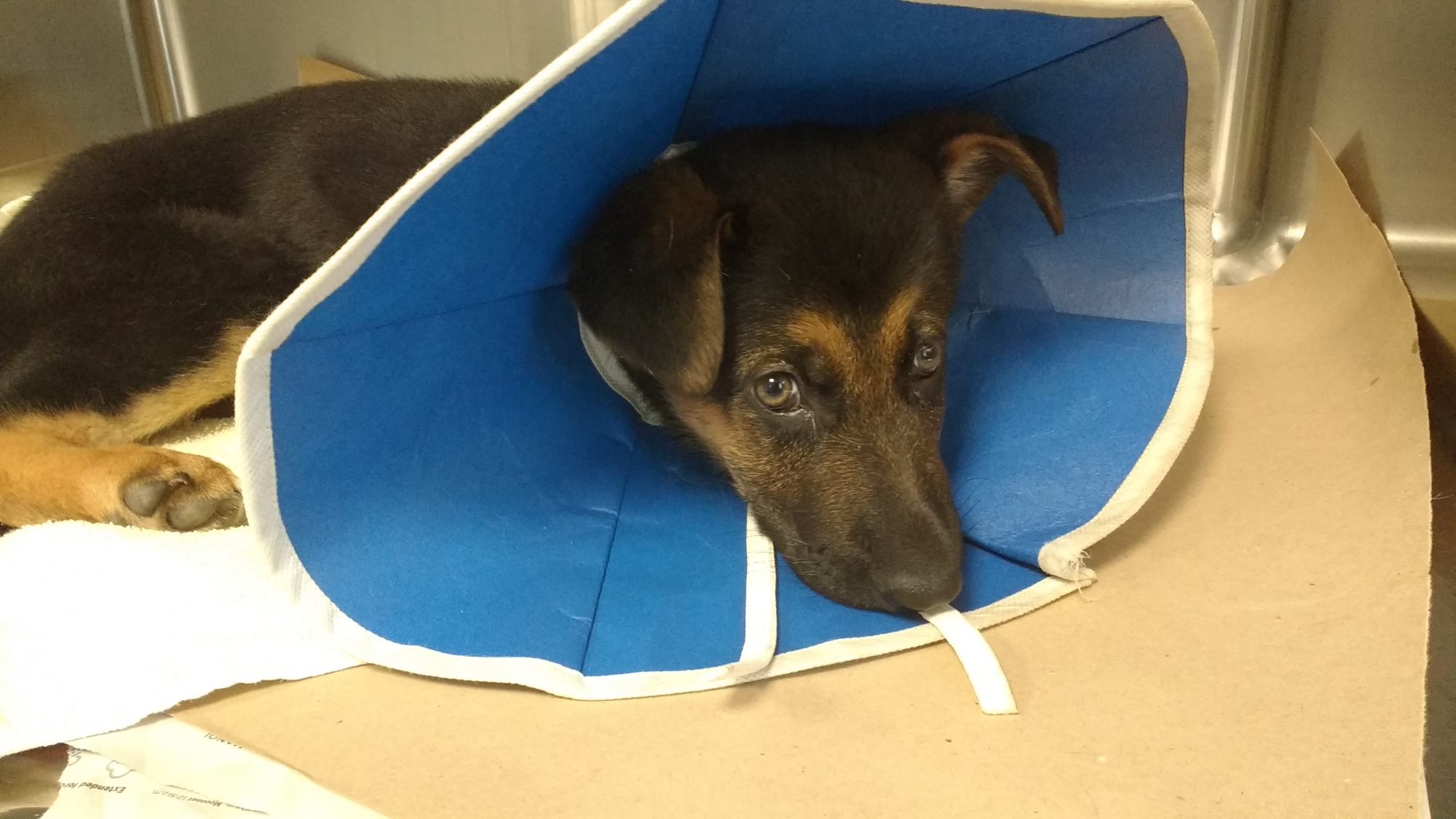
He was rushed to the local emergency clinic, where he was treated for his injuries. He had a large amount of swelling on the top of his head, which raised suspicion that he may have significant injuries to his skull.
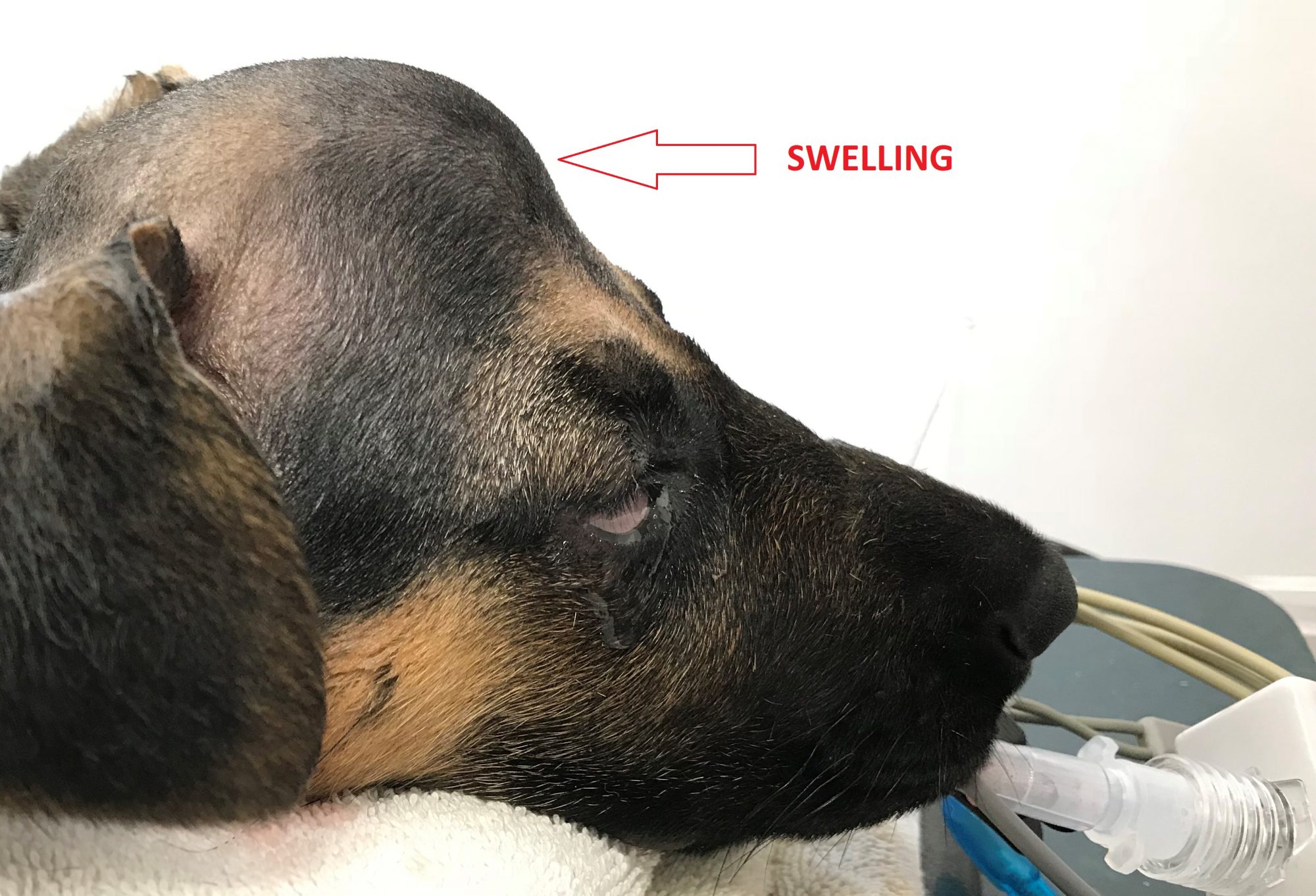
X-rays confirmed that Major had multiple fractures in his skull. He also seemed to be blind, so brain trauma was suspected.
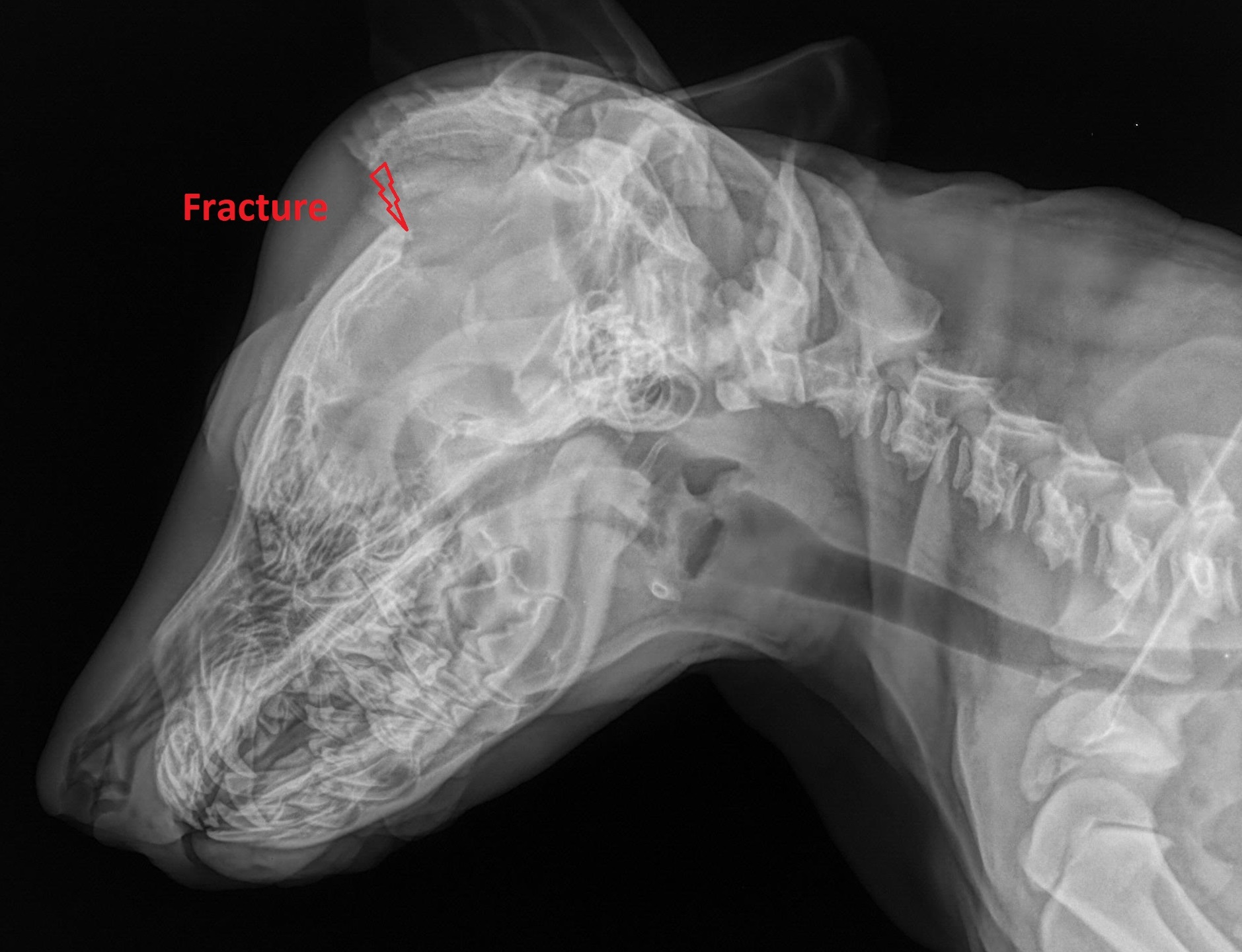
The emergency doctor called me to see if I would be willing to perform surgery to put this puppy back together. I told him that because of the amount of swelling and trauma, surgery would have to wait a few days for the swelling to decrease. I did not feel that I could successfully do surgery without causing additional injury with that much swelling.
A few days went by, Major was a much happier camper. It was unclear whether he could see, but he still reacted like a puppy when you walked up to his cage.
X-rays were repeated 5 days after the injury. They revealed that the swelling around the skull fracture had gone down, even though he still had a large lump on the top of his head. At that point, we decided to go ahead with surgery to repair the fracture.
Major was placed under general anesthesia and prepped for surgery. Anesthesia for brain surgery is risky. In order to decrease swelling of the brain itself, the anesthesia nurse had to keep his CO2 as low as reasonable throughout surgery.
After the skin incision, we confirmed that the massive swelling was a giant blood clot. I decided not to share those pictures… they are a bit too graphic…
After we cleaned out the giant blood clot, the fractures became visible. Of all the broken pieces, two main ones needed to be repaired. The tiny pieces had to be sacrificed.
With great care, in order not to damage the brain, holes were drilled in the skull and the fractured pieces. Suture (rather than metal wire) was used to secure the fragments in place. Over time, the suture material will be absorbed by the body.
WARNING – THE NEXT PICTURE IS GRAPHIC !!!
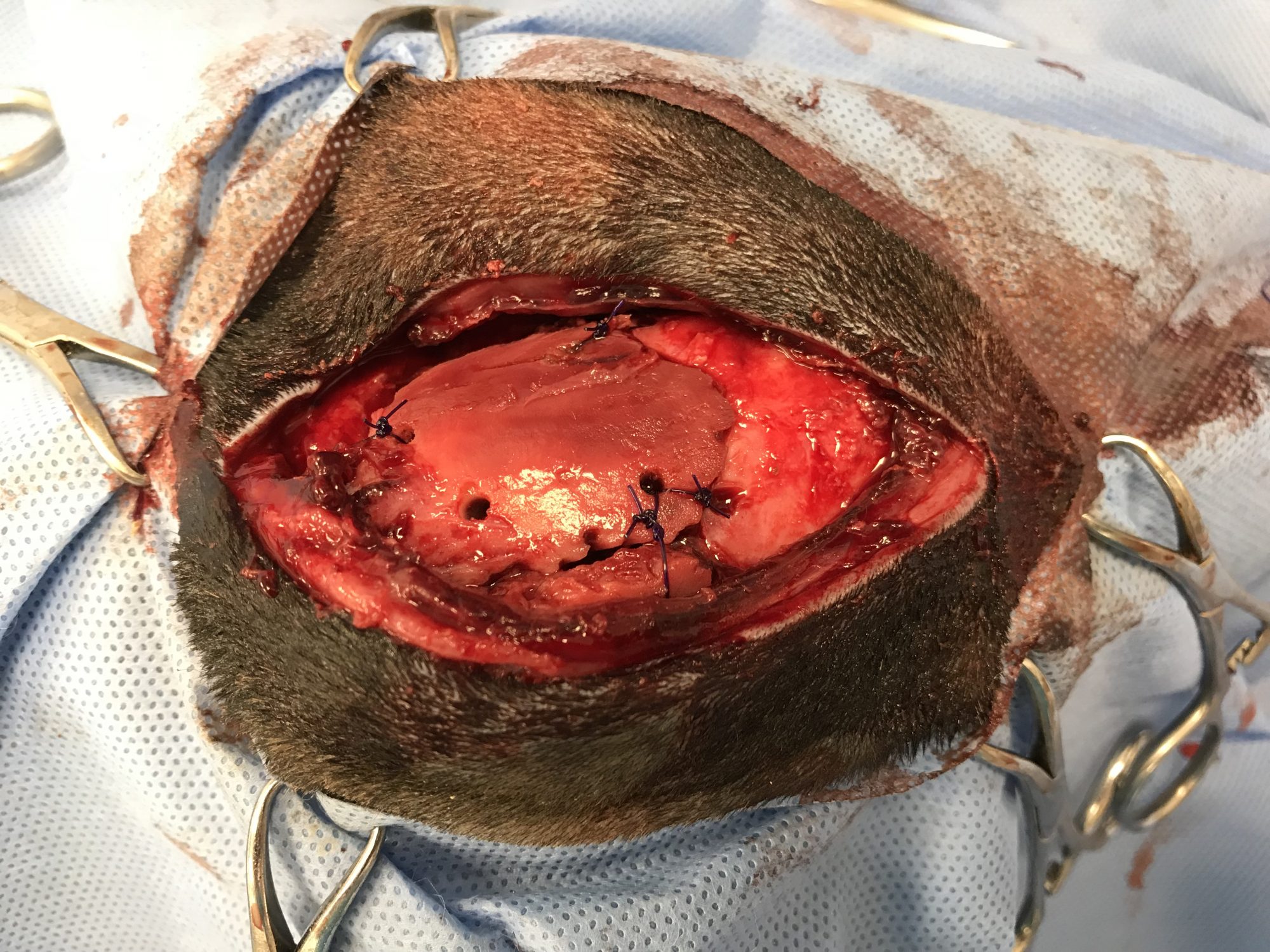
After surgery, the swelling was dramatically less (see the before and after pictures below).

Before Surgery
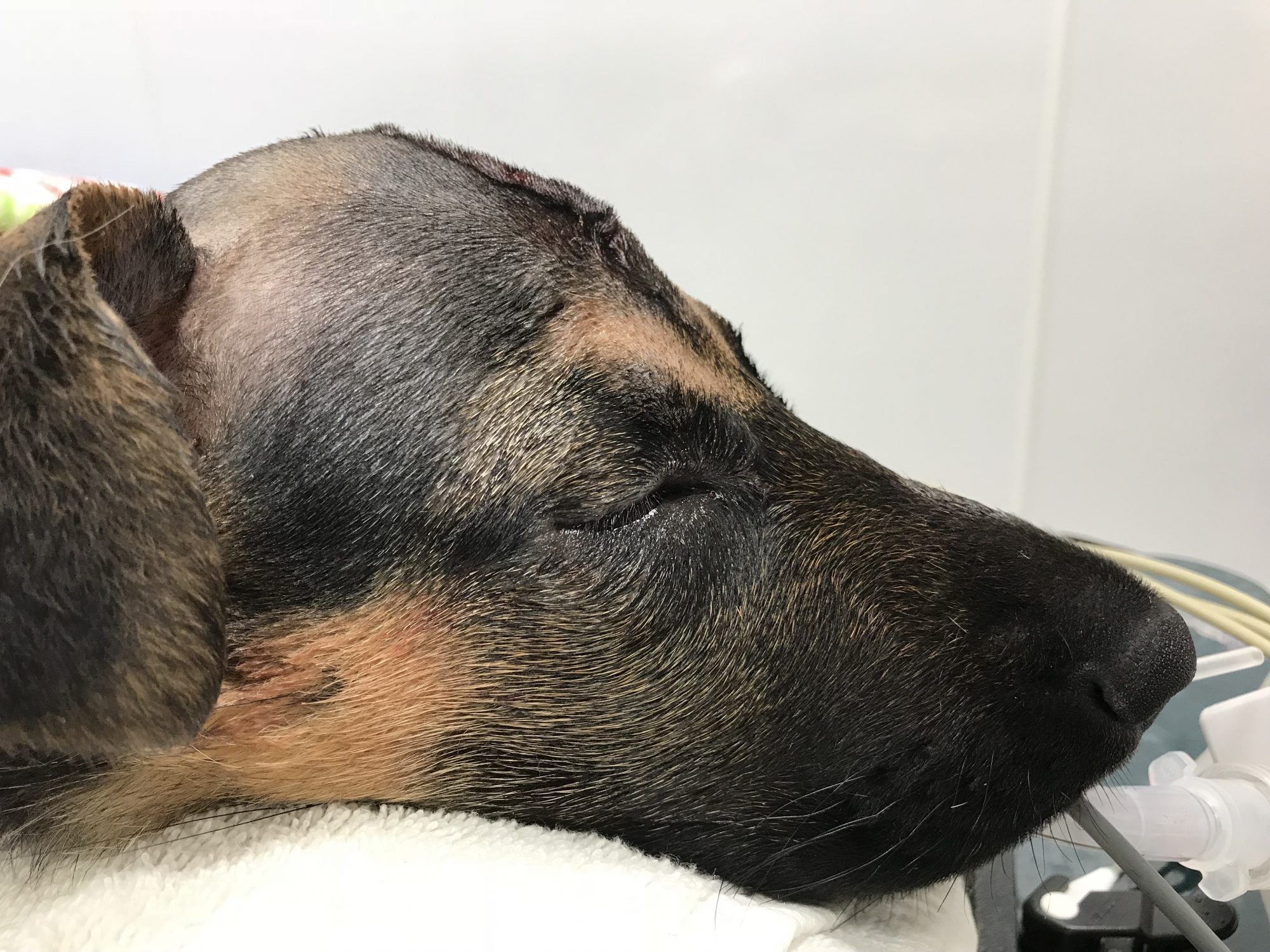
After Surgery
Major recovered smoothly after surgery, and surprisingly he was able to go home the very next day!
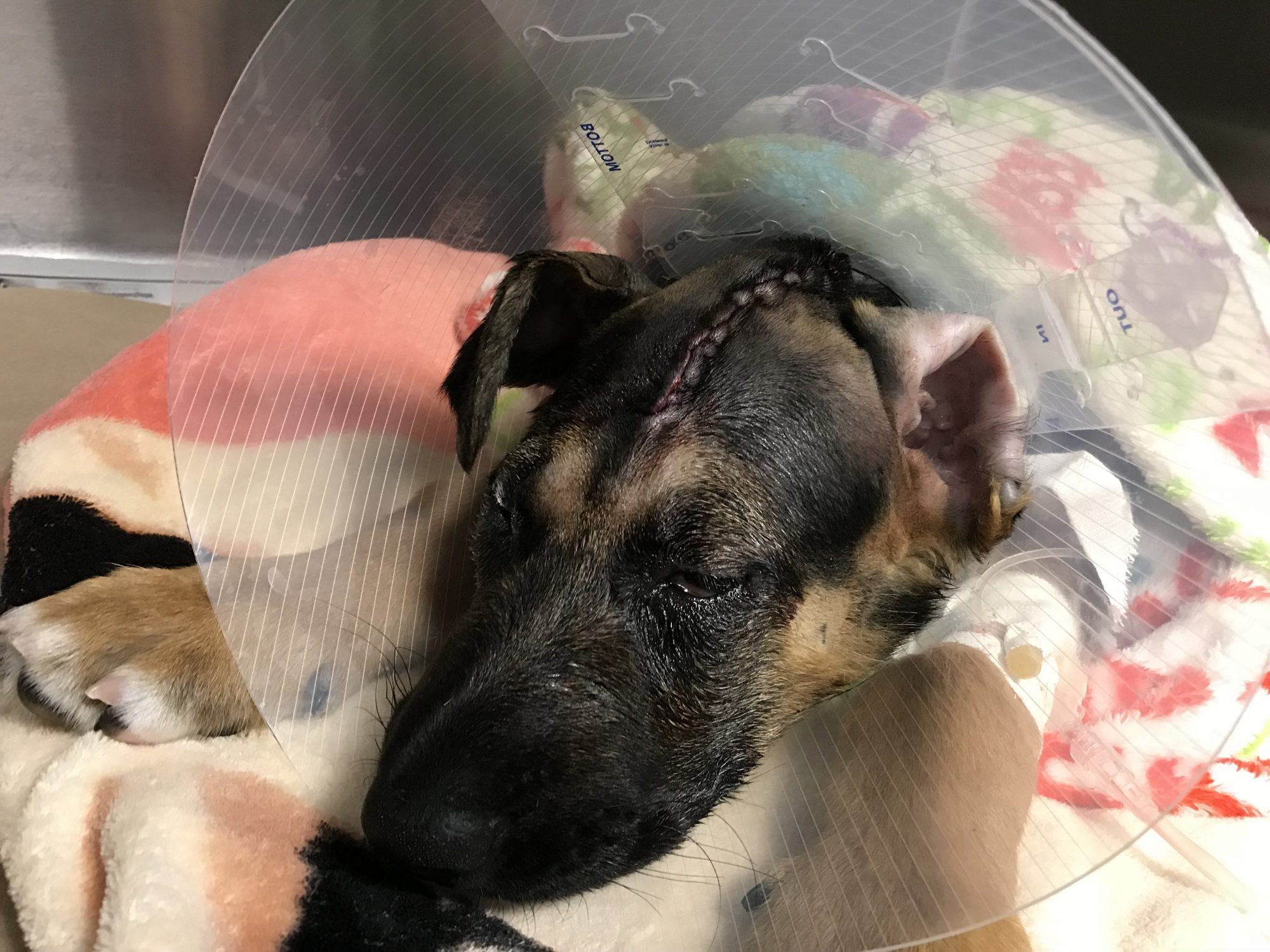
After one month, skull X-rays looked good enough that it was time to allow Major to progressively increase his activity (see the before and after X-rays below).

Before Surgery
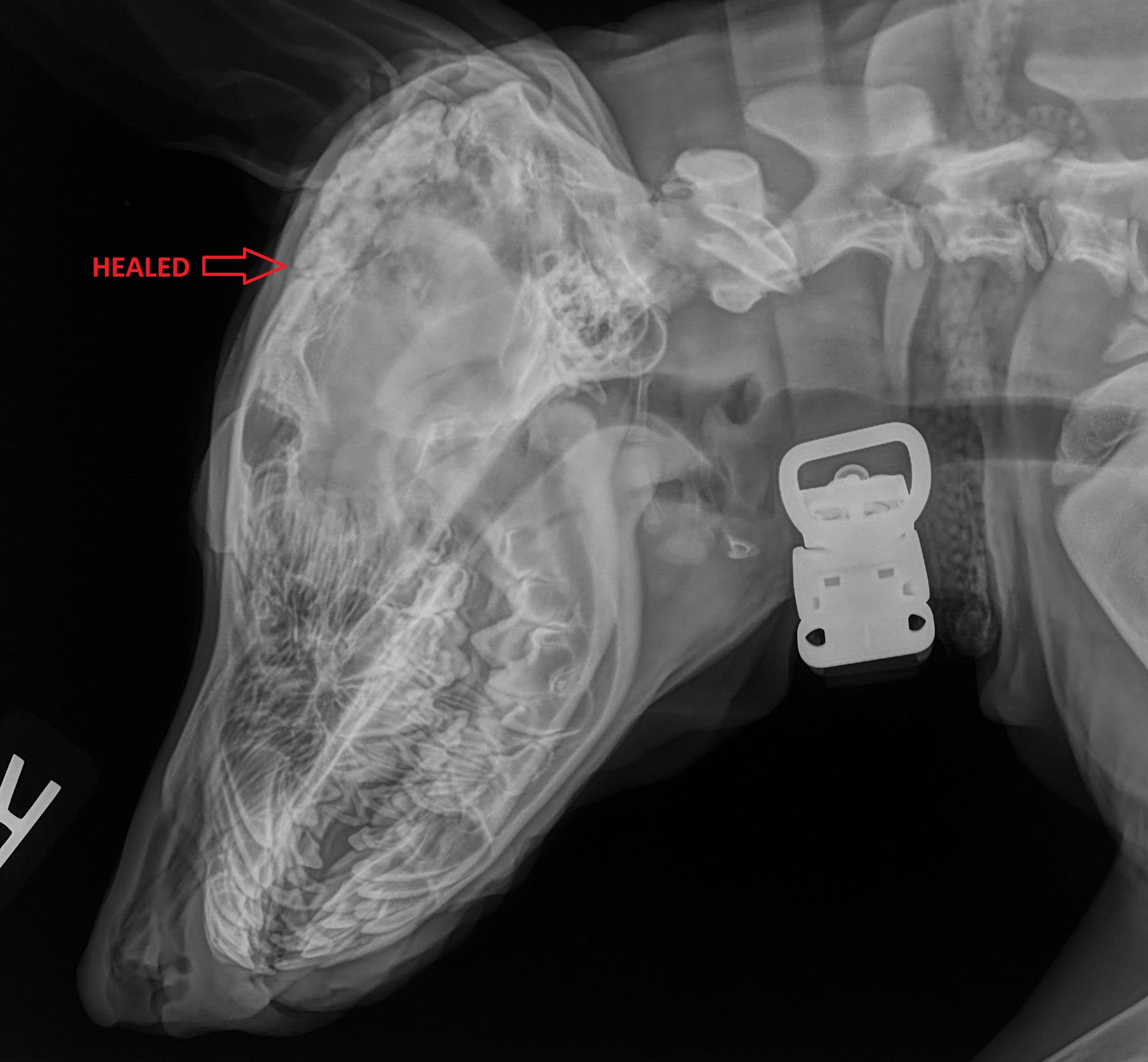
After Surgery
The end result is shown in this video shared by Major’s owner: https://www.youtube.com/watch?v=l5B8AUyW5JE
The video is only 24 seconds, but it’s guaranteed to put a smile on your face!
Major’s owner final report was:
“Major is doing great. His vision is so so. I think he is totally blind in his right eye. His left eye is not 100 percent but he manages to get around great.
Our back yard is fenced in, so he loves being outside playing with his best friend, our cat.
I’m hoping to start him back in obedience school next.
Thank you for saving our puppy.”
Phil Zeltzman, DVM, DACVS, CVJ, Fear Free Certified

Dr. Phil Zeltzman is a traveling veterinary surgeon in Pennsylvania & New Jersey. An award-winning author, he loves to share his adventures in practice along with information about vet medicine and surgery that can really help your pets. Dr. Zeltzman specializes in orthopedic, neurologic, cancer, and soft tissue surgeries for dogs, cats, and small exotics. By working with local family vets, he offers the best surgical care, safest anesthesia, and utmost pain management to all his patients. Sign up to get an email when he updates his blog, and follow him on Facebook, too!
Harper the Greyhound needs reconstructive surgery of… the lip
Harper, a 7 year old greyhound, had a fleshy mass the size of a silver dollar inside her right upper lip.
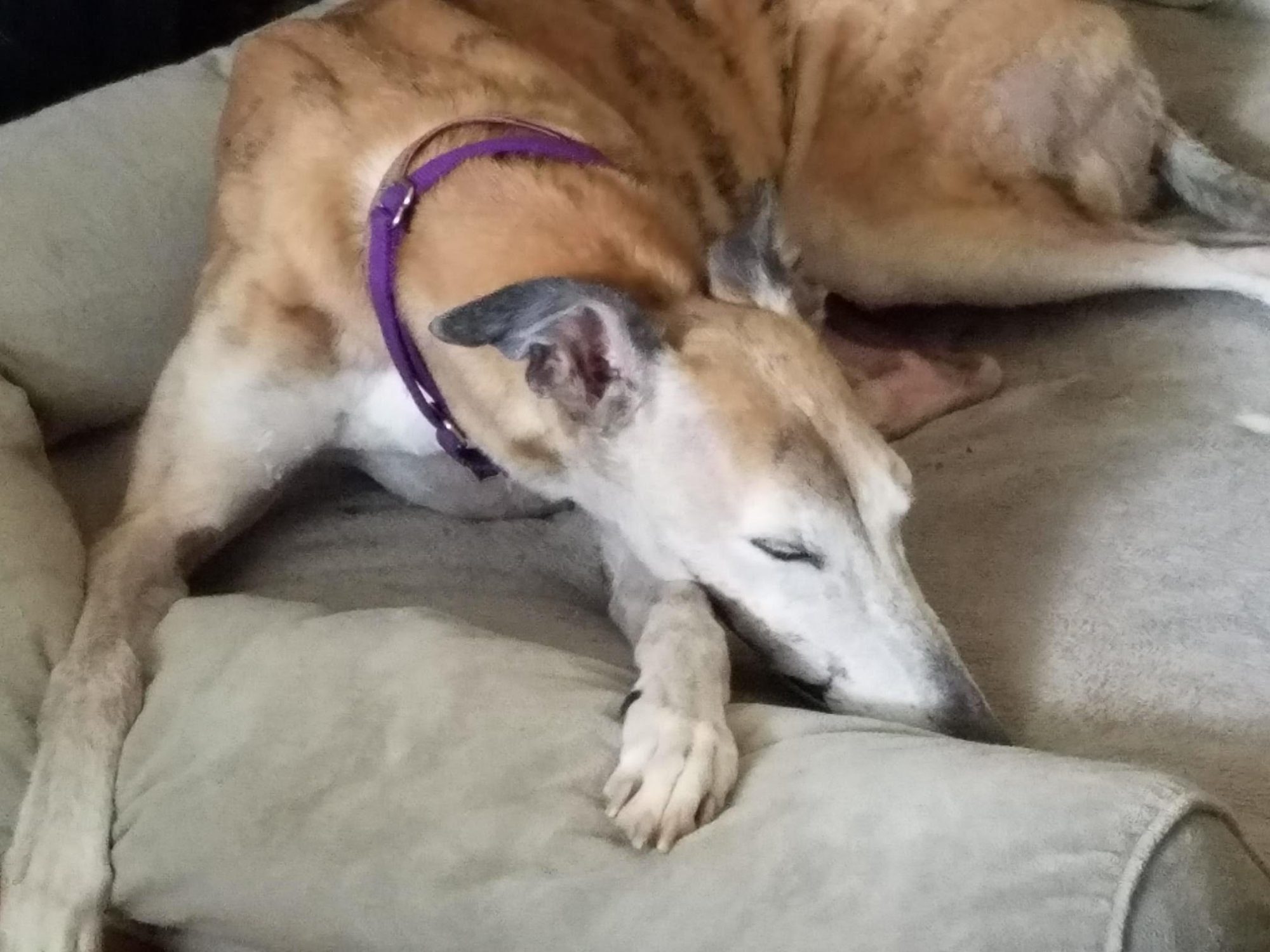
Her family vet did a “debulking” surgery to try and remove as much of the mass as possible without removing the lip itself. The tissue removed from Harper’s mouth was sent to the lab for biopsy. The biopsy revealed a mast cell tumor, which is unusual in the mouth.
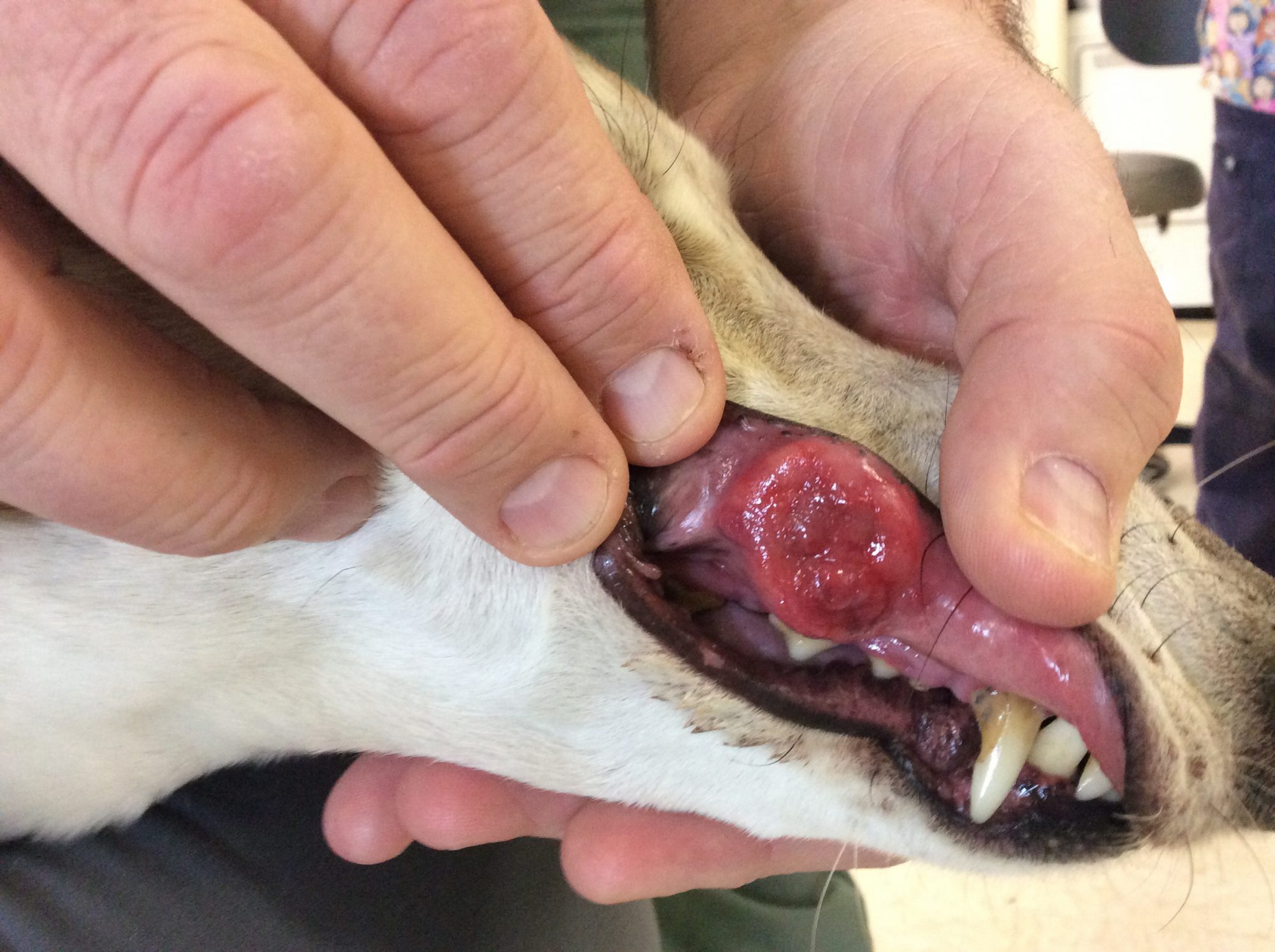
Mast cells are normal white blood cells we all have. They play a role in the body’s response to allergies and inflammation. Sometimes, they become cancerous, most commonly in the skin.
Occasionally, they can affect other body parts, such as the spleen, the liver or the intestine… or the mouth as in Harper’s case.
Complete removal of the mass is the ideal treatment. When we try to get “clean edges” in surgery, we call it getting “clean margins”.
More aggressive tumors or “dirty margins” (i.e. when the tumor was not completely removed) sometimes require additional treatment such as radiation or chemotherapy.
Unfortunately for Harper, due to the size and location of her mass, clear margins were not obtained with her first surgery. That’s when I was called in to perform a more invasive surgery, which would require reconstructive surgery.
To ensure clean margins were achieved this time around, I needed to remove a big chunk of Harper’s lip.
This left us with a hole I had to get creative to close.
I used what is called a skin flap. Using skin from the cheek, and by pulling it into the surgical area, I was able to reconstruct Harper’s upper lip (the pictures are a bit too graphic for this humble blog). There was some considerable pressure along the incision postop, which was a concern for healing. There was a chance the stitches would not hold up…
Harper recovered smoothly from anesthesia. She went home with instructions to keep her quiet and to prevent her from chewing on anything, including toys. The incision had to be protected at all time with a plastic cone (E collar).
About a week later, the biopsy was read as a mast cell tumor – no surprise there. The great news was that we were able to “get it all”, i.e. we had clean margins.
Three weeks later, Harper showed good healing, but I was concerned that the incision looked so crusty. Rather than aggravating the incision by removing the stitches and the scabs, we decided to leave the sutures in for an additional week.
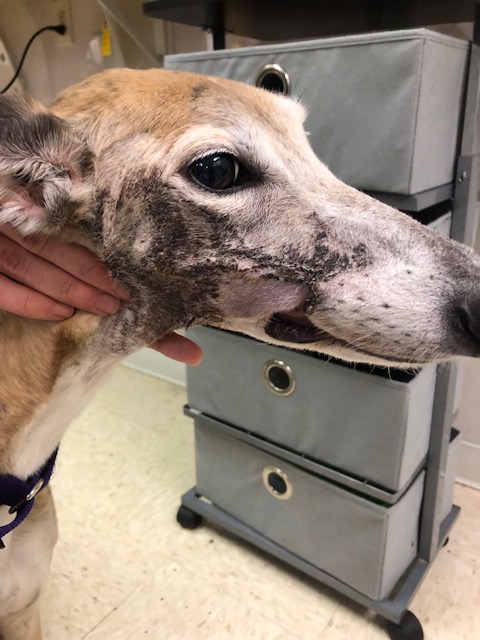
Harper was able to open and close her mouth without any issues, which was a huge relief. Her family vet was able to take a picture while she was yawning at the clinic!
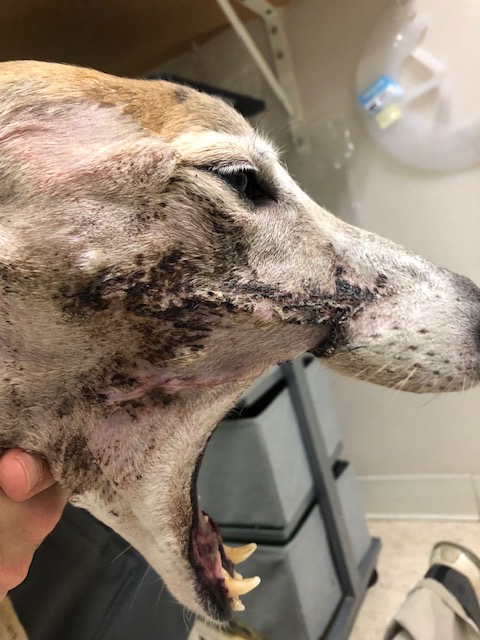
That showed us that Harper could fully open her mouth. It turn, it meant that she could play with chew toys and balls in the future.
One week later (1 month after surgery), the incision looked immensely better. The stitches were removed. And Harper could resume her normal activity.
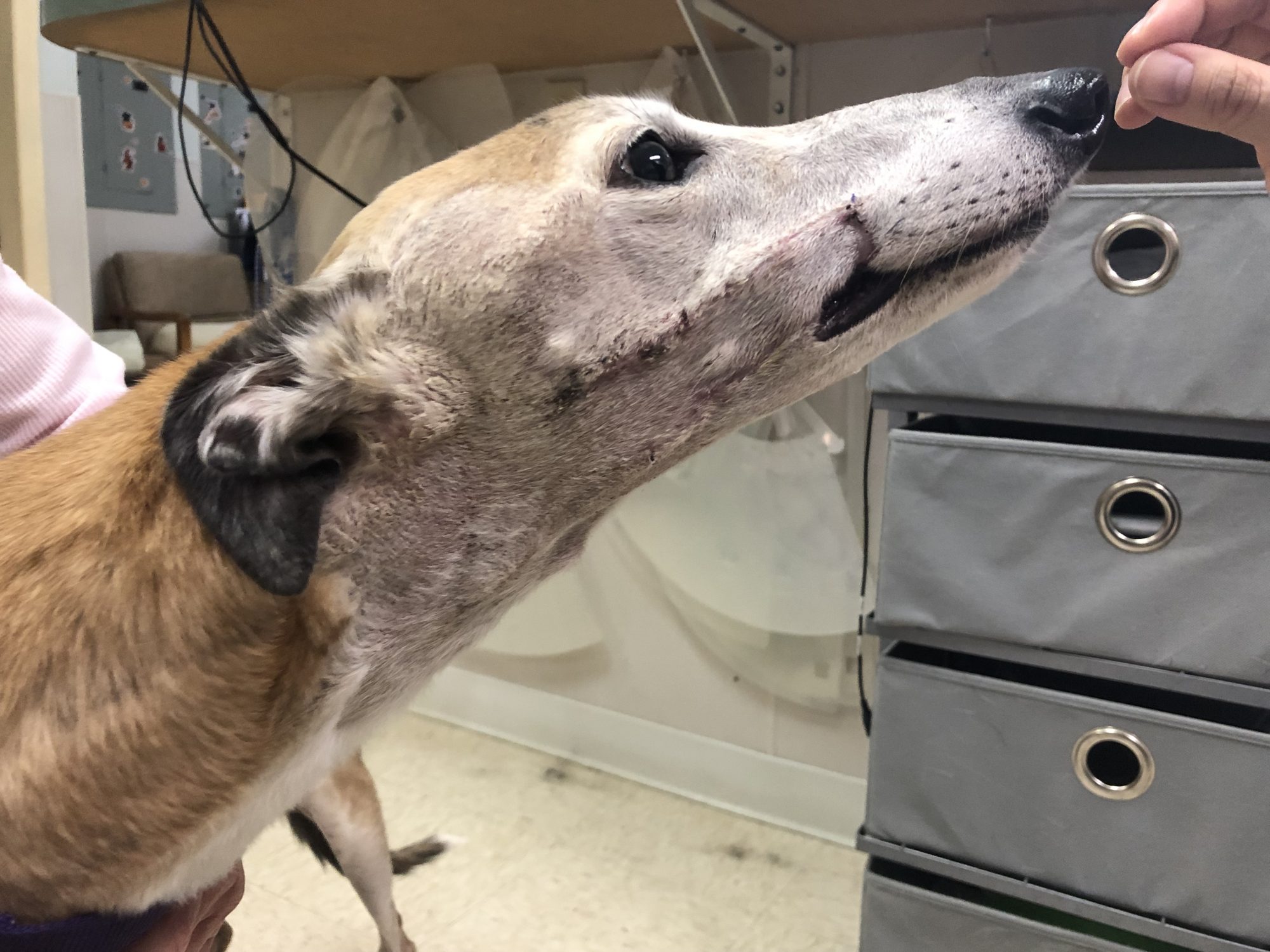
Harper’s mouth will be checked by her family vet during regular check-ups. She is still doing great 6 months after surgery.
Her owner GK wrote:
“Hello Dr. Zeltzman,
We wanted to share with you how happy we are with the outcome from Harper’s surgery.
She looks absolutely fantastic, with her scar only being approximately 1/2 inch long.
The healing process was a little rough in the beginning but with all the excellent instructions we were given we knew what to expect.
But overall it seemed to be a quick process and Harper is as good as new and back to her silly greyhound antics.
Thank you for taking such excellent care of our girl.”
Phil Zeltzman, DVM, DACVS, CVJ, Fear Free Certified

Dr. Phil Zeltzman is a traveling veterinary surgeon in Pennsylvania & New Jersey. An award-winning author, he loves to share his adventures in practice along with information about vet medicine and surgery that can really help your pets. Dr. Zeltzman specializes in orthopedic, neurologic, cancer, and soft tissue surgeries for dogs, cats, and small exotics. By working with local family vets, he offers the best surgical care, safest anesthesia, and utmost pain management to all his patients. Sign up to get an email when he updates his blog, and follow him on Facebook, too!
My coolest surgery last year!
Imagine my surprise when one of my practices asked me if I’d be willing to repair a broken bone in a fox!

Of course, I instantly replied YES!
A 2 year old fox had likely been hit by a car. He was found by a rescue and brought to the clinic. X-rays showed a fractured left humerus (the bone in the arm). It was repaired with a metal pin, which slipped out of the bone – twice.
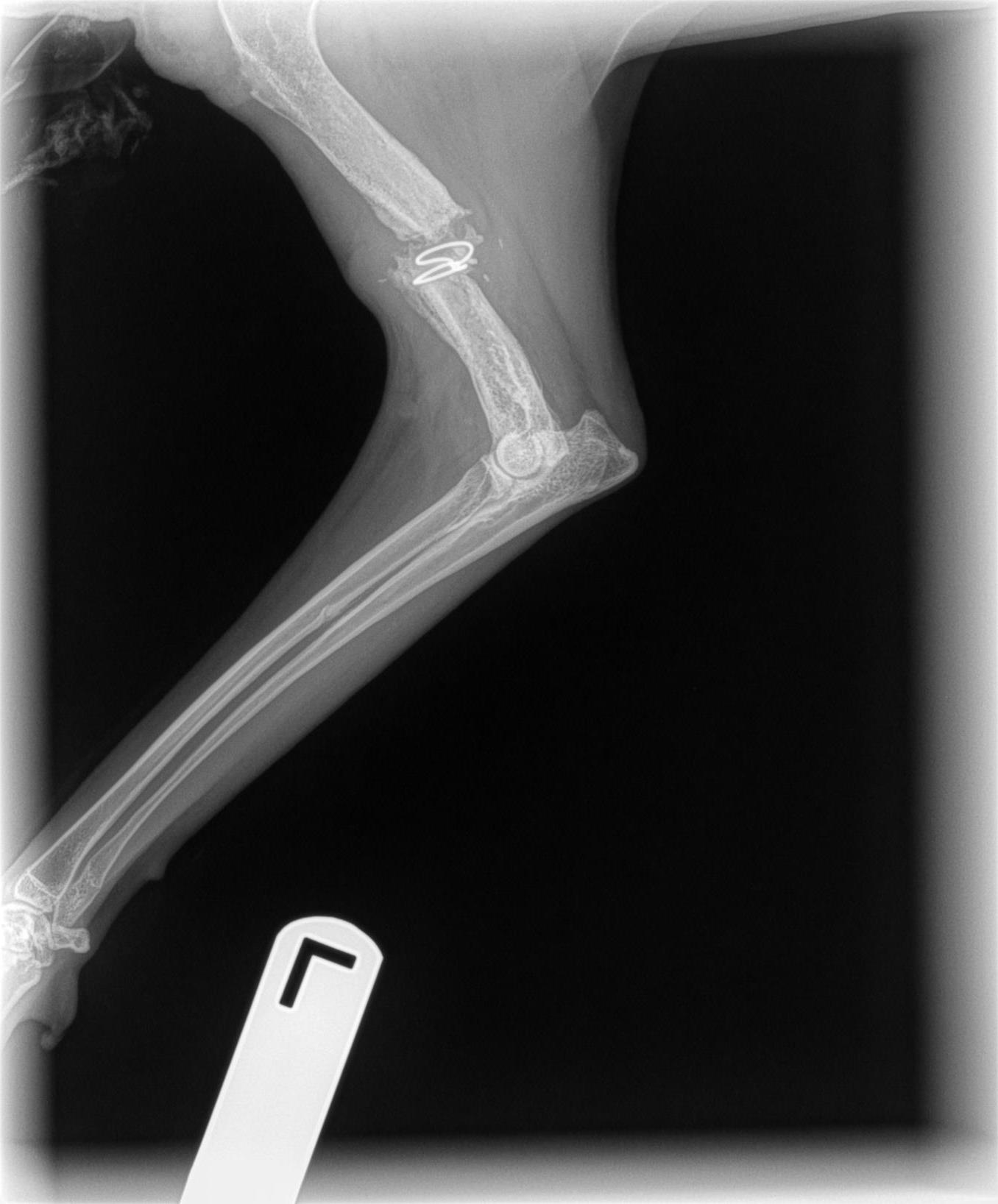
I was later called to the practice to repair the bone. The first thing I did is rename my new patient. “Case # 3781” didn’t sound very good. I thought that “Robin Hood” was more appropriate.
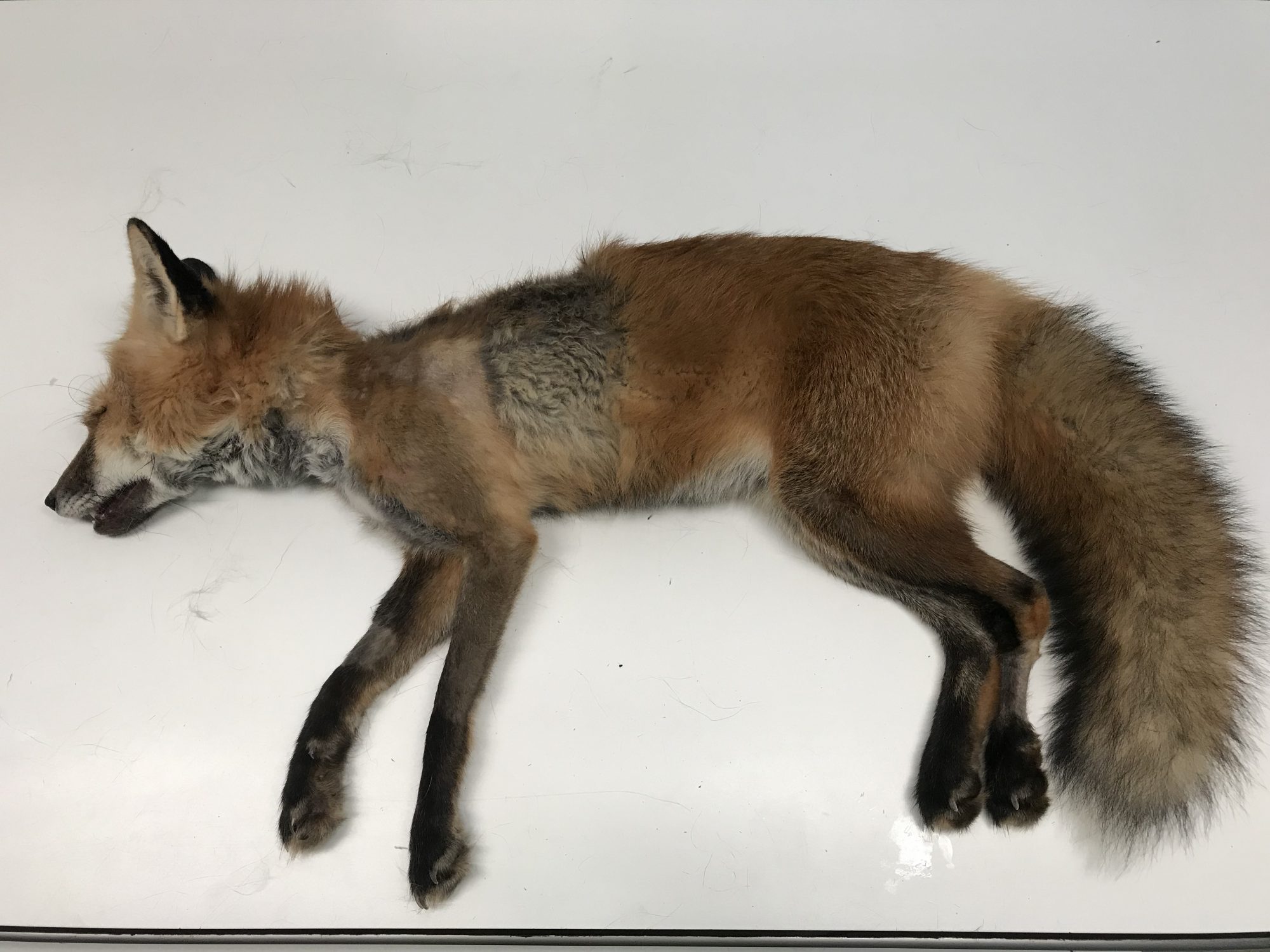
Fox sedated on the X-ray table
My amazing nurses treated him like a dog: IV catheter, IV fluids, pain medications, antibiotics – the works. Our fox friend was put under anesthesia and his beautiful red fur was clipped.
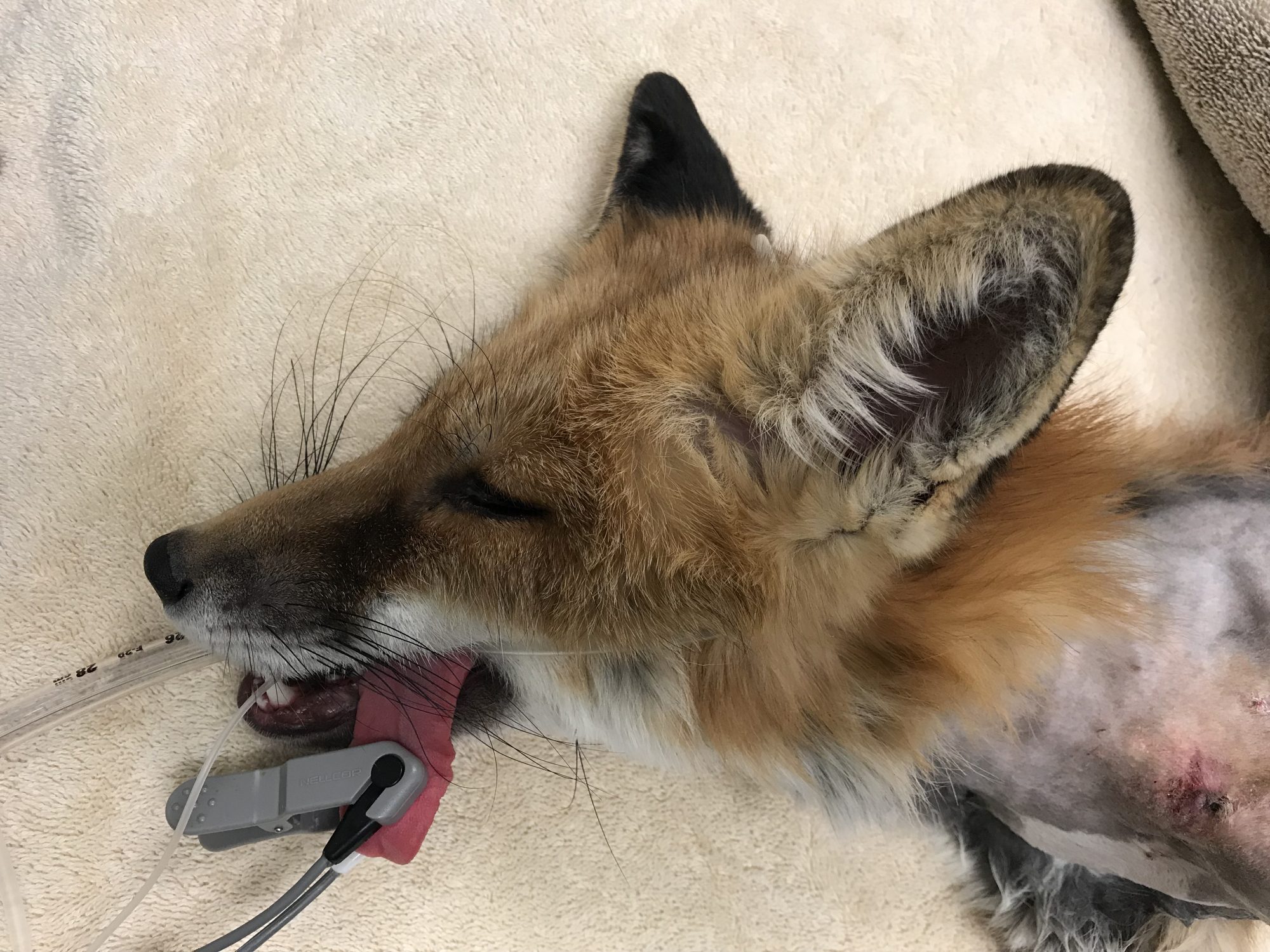
Then surgery started. Several months after the initial accident, there was a lot of scar tissue between the ends of the bone, which were not very healthy. During a more than 3 hour long surgery, the bone was repaired with a metal plate and 9 screws. A bone graft was added to speed up healing, since the fracture site was so unhealthy.
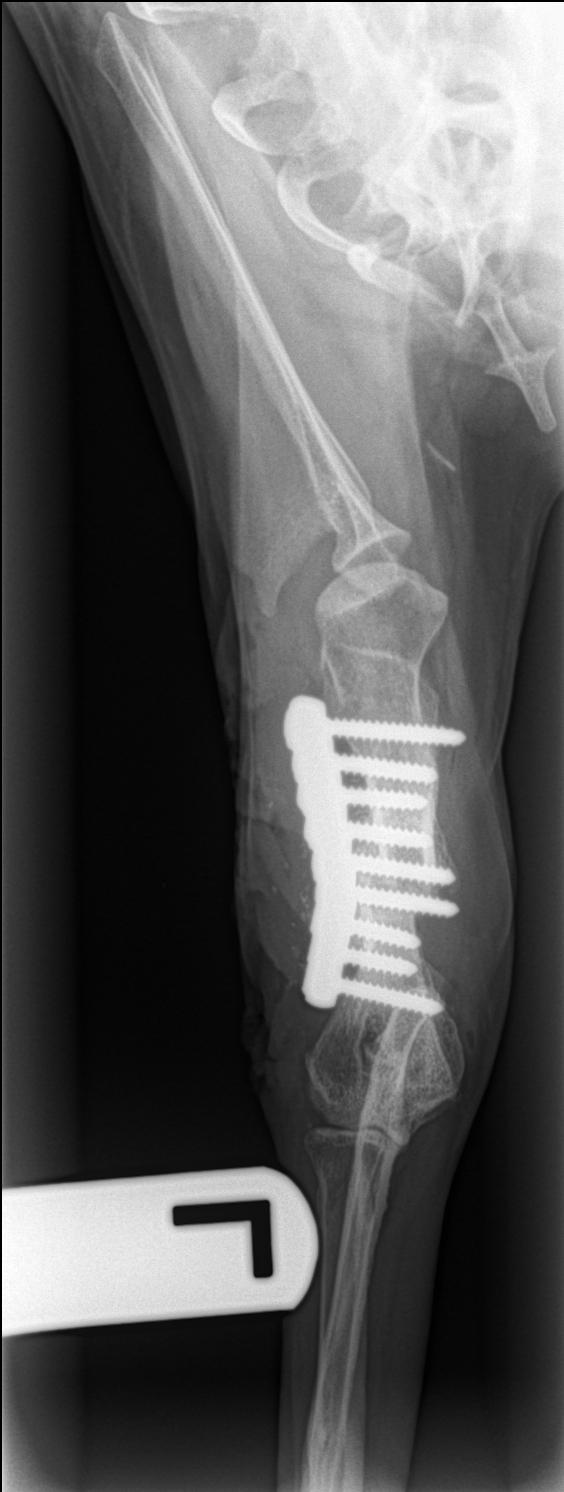
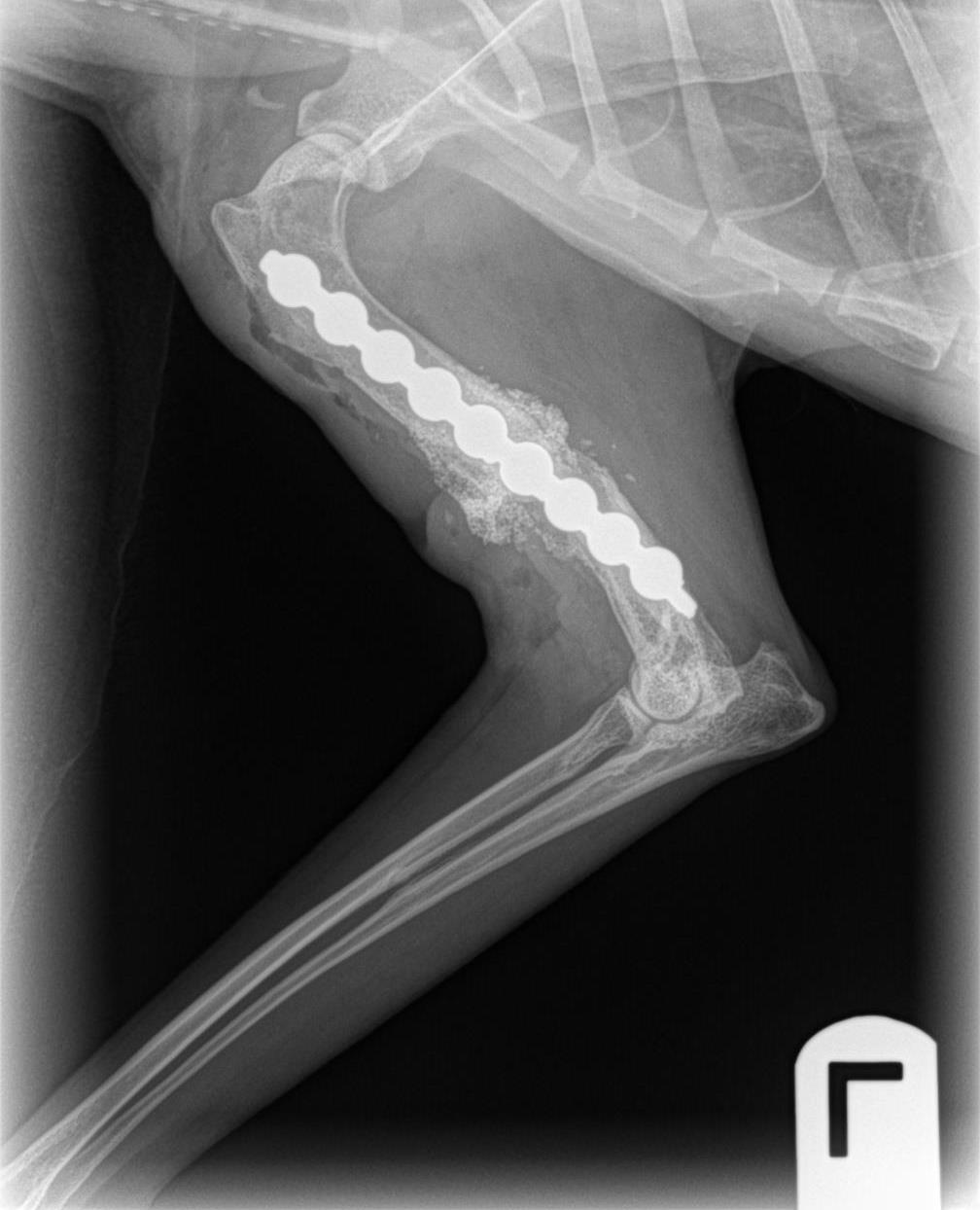
The fox went back to the rescue to heal in a small enclosure. Amazingly, he tolerated a “cone” (E collar) around his head so he wouldn’t lick the incision.
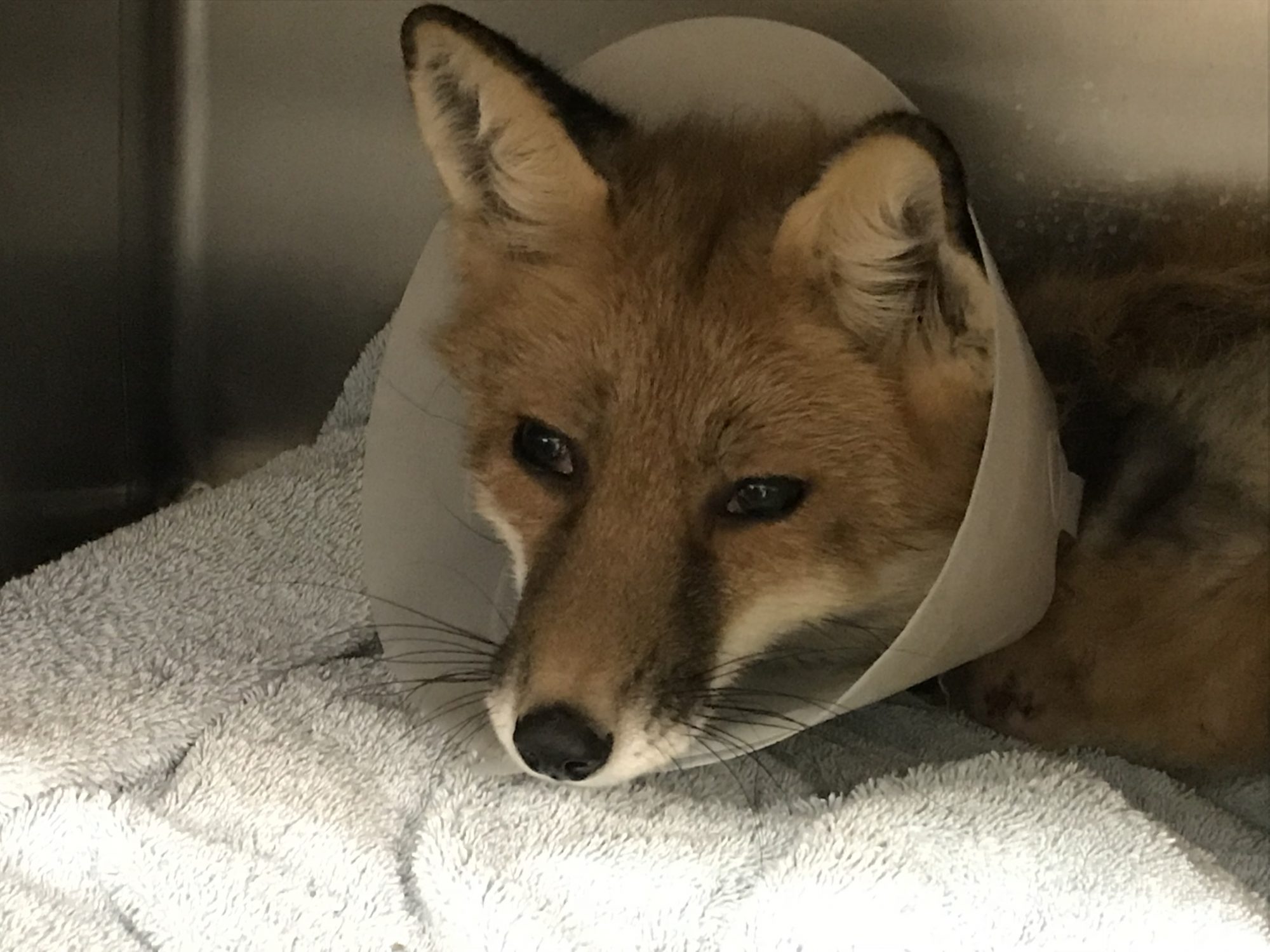
After a month, X-rays were taken under sedation. I was absolutely shocked to see that the bone looked completely healed. In a dog or a cat, it would have taken at least 2 months for such an old fracture to heal.
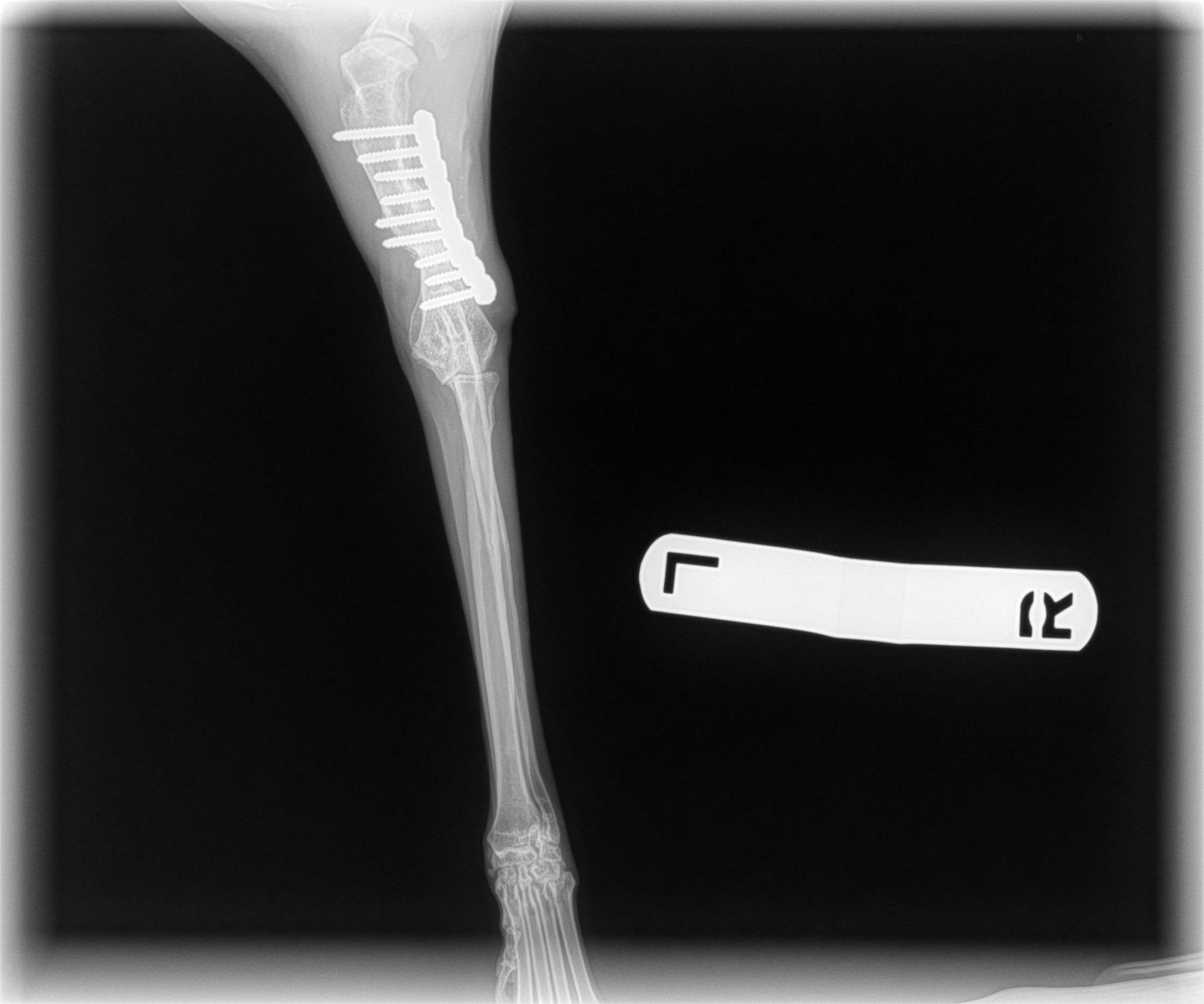
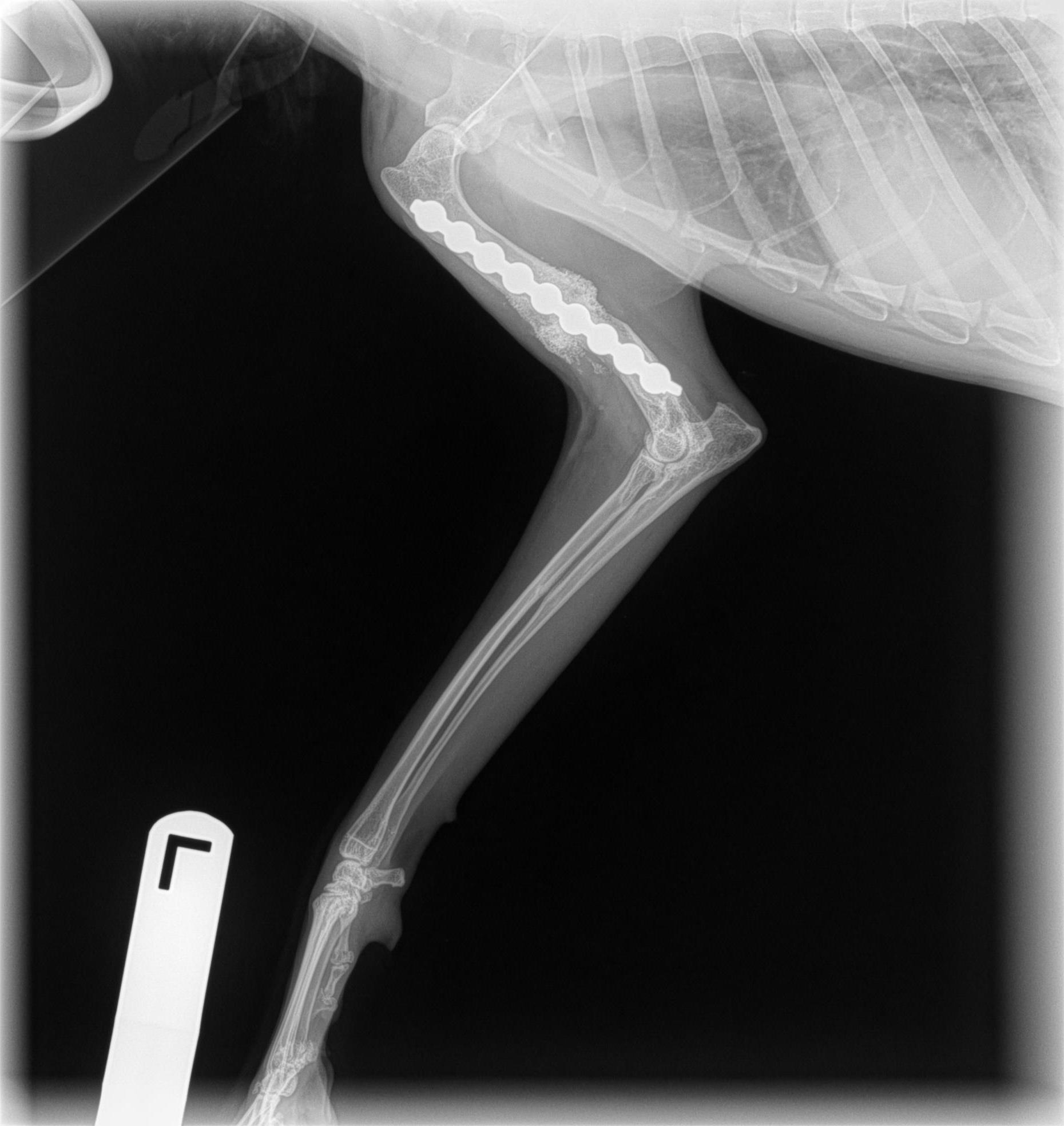
Since the goal was to release Robin Hood in the Wild, I thought that it would be prudent to confine him for another month.
After two months, more X-rays were taken. They confirmed that the bone was healed.
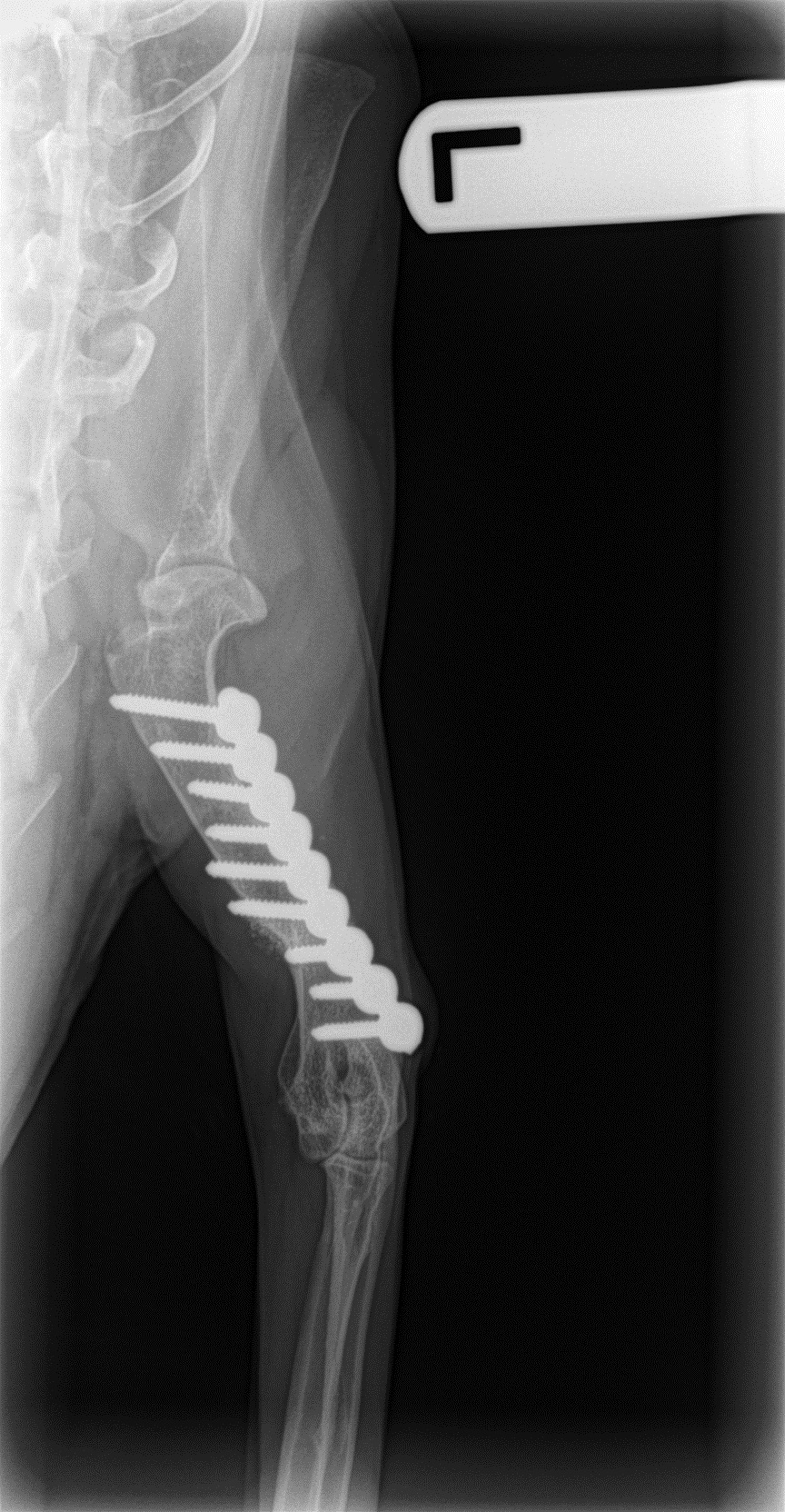
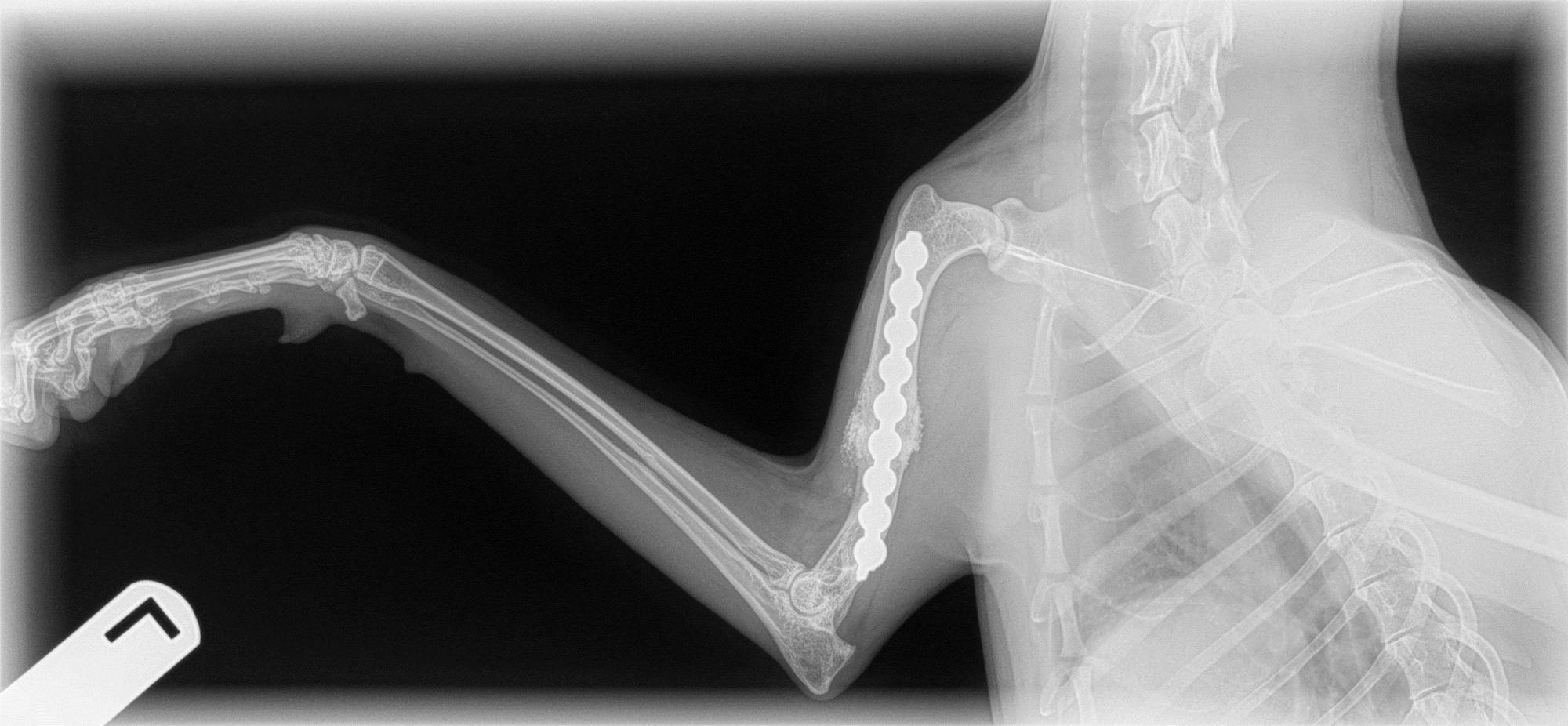
Because it was still winter (early 2019), the rescue wanted to make absolutely sure that Robin Hood would be able to feed himself in the Wild. After all, he had been fed by humans for the past few months, and we needed to play it safe.
Over the next few weeks, Robin Hood was given more and more freedom. He was then allowed to hunt to feed himself. Once he could do that, it was time to release him in the Wild.
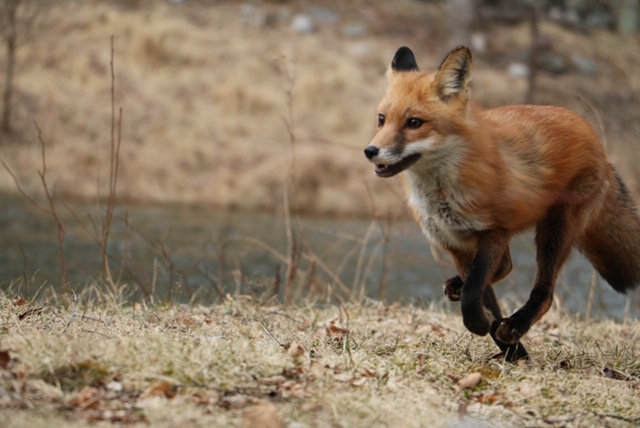
This short video shows this incredible and emotional moment.
https://www.youtube.com/watch?v=GY_ViY9x1dQ
Please keep in mind that handling wildlife requires special skills and permits. Although foxes are extremely cute, they cannot be treated like our domestic friends. In addition, some wild animals may have rabies, which is deadly.
Fortunately, Robin Hood didn’t have rabies and allowed generous humans to help him get back to the Wild.
I am very grateful to this rescue organization for their amazing dedication during this long recovery – and for allowing me to help Robin Hood.
Phil Zeltzman, DVM, DACVS, CVJ, Fear Free Certified

Dr. Phil Zeltzman is a traveling veterinary surgeon in Pennsylvania & New Jersey. An award-winning author, he loves to share his adventures in practice along with information about vet medicine and surgery that can really help your pets. Dr. Zeltzman specializes in orthopedic, neurologic, cancer, and soft tissue surgeries for dogs, cats, and small exotics. By working with local family vets, he offers the best surgical care, safest anesthesia, and utmost pain management to all his patients. Sign up to get an email when he updates his blog, and follow him on Facebook, too!

